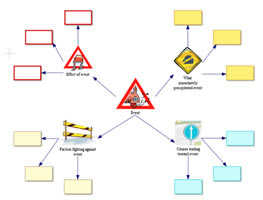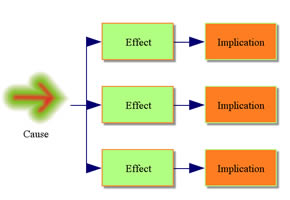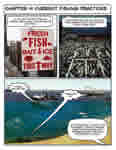Inquiry-based Learning: An Example
Annette Lamb (1997) developed a model called the 8Ws using everyday terms to describe the inquiry process. The Ws are explained below within the context of Callison's components of information inquiry. Daniel Callison (2002) identified five components of information inquiry: questioning and exploration, assimilation and inference, and reflection. Callison states that inquiry can address a workplace or professional problem, academic information task assigned by a teacher, or personal information need. When these three areas overlap, authentic learning can occur.
 Questioning and Exploring
Questioning and Exploring
The inquiry process begins with an open mind that observes the world and ponders the possibilities.
Watching asks inquirers to become observers of their environment becoming in tune with the world around them from family needs to global concerns. Encourage young people to read the new at USA Today, CNN, CBC, BBC, Reuters, PBS, and other news outlets.
I read part of the book Our Choice by Al Gore. I got the new iPad app. It made me think about our oceans. I watched the award winning documentary A Sea Change. I was shocked and wanted to learn more about whether the future might be "a world without fish." Is ocean acidification really going to kill all the fish?
Wondering focuses on brainstorming options, discussing ideas, identifying problems, and developing questions.
I watched Mark Kurlansky talk about his new book World Without Fish on YouTube. I used Zamzar (SaveYouTube) to download clips to share in class. I also shared the comic series. I also checked out The Last Fish Tale, the Big Oyster, and Cod by Mark Kurlansky to explore more about the history of fish.
Exploration involves observing the world, investigating possibilities, collecting resources, interviewing experts, and experimenting with ideas.
Webbing involves students in identifying and connecting ideas and information. Data is located and relevant resources are organized into meaningful clusters. One piece of information may lead to new questions and areas of interest.
After examining infographics: Earth's CO2, Fish Stocking and Which Fish to Eat I have a lot more questions about marine life. I wondered how scientists collect information to determine the impact of things like oil disasters, overfishing, ocean acidification, pollution, and climate change. I've been exploring information about Climate Change and Marine Life through Google Earth. Experiences such as Prince William's Oily Mess: A Tale of Recovery - Graphic Changes in Marine Life: Working with Real Data provided real-world applications of science.
Exploring leads back to questioning. Questions may be refined, restated, or new queries may emerge.
Assimilating and Inferring
Assimilation involves processing, associating, and integrating new ideas with already available knowledge in the human mind. This can be the toughest phase for young people because they may be uncertain about what they've found and where they're going.
Wiggling involves evaluating content, along with twisting and turning information looking for clues, ideas, and perspectives.
Inspiration templates are useful in organizing information. Inspiration provides two templates that focus on causality and cause/effect that would be useful for this type of thinking.
Marine life is changing. However what is the root cause? Is it overfishing, pollution, ocean acidification, climate change or a combination? What is the impact of each element? How do they impact each other? What must be done?


Next, young people apply evidence to solve problems and make decisions.
Weaving consists of organizing ideas, creating models, and formulating plans. It focuses on the application, analysis, and synthesis of information.
I've been thinking about all the organizations that support marine life. Each of these groups has a different perspective on marine life issues, causes, and solutions. I analyzed the text and photographs on their page. I created a diagram to show how their approaches were alike and different.
- Blue Ocean
- Cousteau Society & Cousteau Kids
- Environmental Defense Fund
- Greenpeace
- Marine Stewardship Council
- Monterey Bay Aquarium
- National Resource Defense Council
- The Nature Conservancy
- Ocean Alliance
- Oceana
- The Whaleman Foundation
As students weigh evidence, they may go back and collect additional information to support their inferences. This process of assimilation and inference reoccurs as young people accumulate information.
Reflection
As students make decisions and solve problems, they think about the process and consider how to share their conclusions and plan for future inquiries.
Wrapping involves creating and packaging ideas and solutions. Why is this important? Who needs to know about it? How can I effectively convey my ideas?
I think teens need to know how to take action and make good decisions about fishing and eating seafood. I created a Glogster poster showing the features of the organization I support and why. I really like the work of the Marine Stewardship Council because they focus on sustainable seafood.
Waving consists of communicating ideas to others through presenting, publishing, and sharing. How will I market my ideas and who will I ask for feedback?
As I read about sustainable fishing and looked at the many photos and diagrams, I realized the importance of sustainable fishing practices. I used Comic Life to create a graphic book about both personal and professional fishing practices. This format is attractive to teens.
Wishing involves assessing, evaluating, and reflecting on the process and product of inquiry. Was the project a success? What will I do next?
I created a YouTube search story as a reflection of my experience searching for information about "a world without fish." Watch the result.
After learning about the all the issues, I began another round of inquiry. I downloaded the Seafood Watch App for iPhone and Android and used the Project Fishmap for iPhone and Android to find local places with sustainable seafood products. I'm going to interview some local restaurant owners about their buying practices.
Dustbowl and Great Depression
 Questioning and Exploring
Questioning and Exploring
The inquiry process begins with an open mind that observes the world and ponders the possibilities.
Watching asks inquirers to become observers of their environment becoming in tune with the world around them from family needs to global concerns. Encourage young people to read the new at USA Today, CNN, CBC, BBC, Reuters, and other news outlets.
I've been watching video, looking at photos, and examining maps about climate change in online news such as USA Today and it made me think about our past and the future. Could the Dust Bowl of the 1930s happen again? What caused it? What environmental changes will happen with climate change?
Wondering focuses on brainstorming options, discussing ideas, identifying problems, and developing questions.
According to the Sanora Babb website, "Random House accepted 'Whose Names Are Unknown' for publication in 1939, then rescinded the contract when Steinbeck's 'Grapes of Wrath' appeared the same year to great acclaim." The books each represent the same time period in different ways. I wonder which is most accurate? Visit the Sanora Babb website to learn more and see photographs.
Exploration involves observing the world, investigating possibilities, collecting resources, interviewing experts, and experimenting with ideas.
Webbing involves students in identifying and connecting ideas and information. Data is located and relevant resources are organized into meaningful clusters. One piece of information may lead to new questions and areas of interest.
I've been thinking about the Great Depression and specifically the Dust Bowl. I starting exploring books such as "Years of Dust" and "Children or the Great Depression" and online photographs at the Library of Congress such as the Voices from the Dust Bowl collection and curriculum materials from the National Archives. Migrant Mother is a powerful photograph. I've been collecting information about Dorothea Lange's photographs during the 1930s. Are her famous images intended to document the Great Depression or provide propaganda for the government? I hoped that reading the book "Dorothea Lange: A Life Beyond Limits" would provide some answers about the photographer and her intentions. It makes sense to tell her story through photos. Here's a photo of Dorothea Lange taken in 1936 around the time she took the famous photograph of the migrant mother. I explored many photographs at Wikimedia Commons which took me back to the original sources.
Exploring leads back to questioning. Questions may be refined, restated, or new queries may emerge.

Assimilating and Inferring
Assimilation involves processing, associating, and integrating new ideas with already available knowledge in the human mind. This can be the toughest phase for young people because they may be uncertain about what they've found and where they're going.
Wiggling involves evaluating content, along with twisting and turning information looking for clues, ideas, and perspectives.
Inspiration templates are useful in organizing information. Inspiration provides two templates that focus on causality and cause/effect that would be useful for this type of thinking.
What caused the Dust Bowl? What was the relationship between the Dust Bowl and the Great Depression? What was the impact of each event? How did they impact each other? Could these two events happen again either together or separately?


Next, young people apply evidence to solve problems and make decisions.
Weaving consists of organizing ideas, creating models, and formulating plans. It focuses on the application, analysis, and synthesis of information.
The National Archives provides new online tools called Docs TEACH. This tools provides a framework for exciting activities.
I created a map activity at the National Archives that show how and why people moved West during the Great Depression.
I created a scrapbook diary for different elements of the Great Depression such as the economic and social aspects. This scrapbook helps me organize my thoughts and also put myself in the shoes of a person living at that time.
 As students weigh evidence, they may go back and collect additional information to support their inferences. This process of assimilation and inference reoccurs as young people accumulate information.
As students weigh evidence, they may go back and collect additional information to support their inferences. This process of assimilation and inference reoccurs as young people accumulate information.
Reflection
As students make decisions and solve problems, they think about the process and consider how to share their conclusions and plan for future inquiries.
Wrapping involves creating and packaging ideas and solutions. Why is this important? Who needs to know about it? How can I effectively convey my ideas?
I'm interested in the impact of the Great Depression and the Dust Bowl on children. I created a story by remixing historical video and images. After reading the book "This Land Was Made for You and Me", I decide to incorporate music by Woody Guthrie. If I share it on YouTube, lots of people will see it.
 Waving consists of communicating ideas to others through presenting, publishing, and sharing. How will I market my ideas and who will I ask for feedback?
Waving consists of communicating ideas to others through presenting, publishing, and sharing. How will I market my ideas and who will I ask for feedback?
As read nonfiction books and looked at the many photos, I wondered about the lives of the people represented in the images. I decided to Integrate historical photos into a fictional graphic story that infuses factual information. I'm using Comic Life. I'm going to talk my friends into adding their short stories to mine. If we get enough, we could publish then using CreateSpace.
Wishing involves assessing, evaluating, and reflecting on the process and product of inquiry. Was the project a success? What will I do next?
After learning about the Dust Bowl, I thought it would be fun to learn more about the tall tales of the time period. I began another round of inquiry. I read the graphic novel The Storm in the Barn by Matt Phelan. Then I read a Jack Tale (Source 1, Source 2). I compared photos of the time period with historical drawings/ Then, I wrote a tale tale using Scratch software and images from Open Clipart Library.
Print Resources
- Children of the Great Depression by Russell Freedman (Juvenile Nonfiction)
- Dorothea Lange: A Life Beyond Limits by Linda Gordon (Biography)
- Dust for Dinner by Ann Turner (Beginning Reader)
- The Dust Bowl Through the Lens by Martin W. Sandler (Juvenile Nonfiction: Photography)
- Grapes of Wrath by John Steinbeck (Teen/Adult Fiction)
- Years of Dust: The Story of the Dust Bowl by Albert Marrin (Juvenile Nonfiction: Photography)
- The Worst Hard Time: The Untold Story of Those Who Survived the Great American Dust Bowl by Timothy Egan (Adult Nonfiction)
- Out of the Dust by Karen Hesse (Teen Fiction)
- The Storm in the Barn by Matt Phelan (Juvenile Graphic Novel)
- This Land was Made for You and Me by Elizabeth Partridge (Juvenile Nonfiction)
- Whose Names Are Unknown by Sandora Babb (Novel)
- Wingwalker by Rosemary Wells and Brian Selznick (Juvenile Fiction: Easy Chapter Book)
Video Resources
- American Experience: Surviving the Dust Bowl
- The Plow that Broke the Plains from Google Video (NARA)
Images Resources
- Flickr: Dorothea Lange, Dust Bowl - The Depression Years, Picturing the 1930s, FSA/OWI Favorites
- Library of Congress: Photographers of the FSA, Voices from the Dust Bowl, Documenting America, Popular Requests, Staff Selections
- Shorpy Image Galleries

For a more in-depth exploration, read the graphic book Graphic Inquiry by Annette Lamb and Danny Callison available from Libraries Unlimited, 2011.





